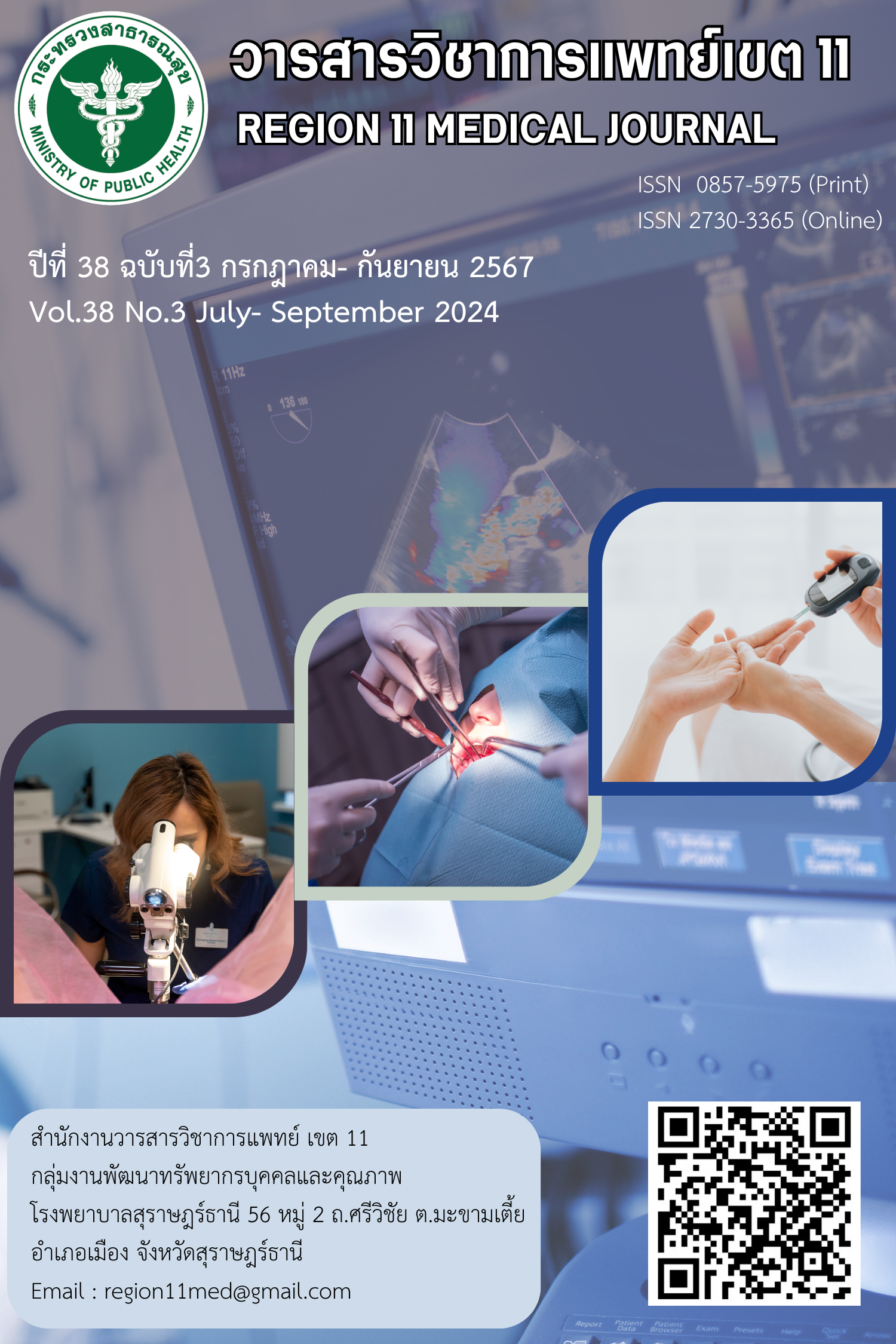ผลของการใช้แนวปฏิบัติการบริหารยาบรรเทาปวดกลุ่ม opioids แบบ range order เพื่อป้องกันภาวะ Opioids-Induced Advancing Sedation (OIAS) ในผู้ป่วยหลังผ่าตัดทรวงอก
คำสำคัญ:
การบริหารยาแบบช่วง, ยาบรรเทาปวด, ผ่าตัดทรวงอกบทคัดย่อ
ที่มา: การจัดการความปวดโดยใช้ยาโอพิออยด์ โดยการสั่งใช้ยาแบบช่วง เป็นความยืดหยุ่นเพื่อให้พยาบาลสามารถใช้ยาโอพิออยด์ในการควบคุมความปวดของผู้ป่วยแต่ละราย ดังนั้นการบริหารยาโอพิออยด์ที่ให้ไม่เหมาะสม ทั้งความถี่ ขนาด ไม่มีการคำนึงถึงปัจจัยเสี่ยงอื่นๆของผู้ป่วยที่ทำให้ยาโอปิออยด์เกินขนาด ไม่มีการเฝ้าระวังติดตามอย่างต่อเนื่อง ทำให้พบอุบัติการณ์ของการเกิดภาวะ Opioids-Induced Advancing Sedation (OIAS)
วัตถุประสงค์: เพื่อศึกษาผลของการใช้การแนวปฏิบัติการบริหารยาบรรเทาปวดกลุ่มโอพิออยด์แบบช่วงเพื่อป้องกันภาวะ (OIAS) ในผู้ป่วยหลังผ่าตัดทรวงอก
วิธีการศึกษา: เป็นการวิจัยเชิงพัฒนา เป็นระยะของการทดสอบประสิทธิผลของแนวปฏิบัติการ (ขั้นตอนที่ 8 ของกรอบแนวคิดการพัฒนาแนวปฏิบัติทางคลินิกของสภาการวิจัยทางการแพทย์และสุขภาพแห่งชาติ ประเทศออสเตรเลีย) กลุ่มตัวอย่างคือ ผู้ป่วยผ่าตัดทรวงอกที่ได้รับยาบรรเทาปวดกลุ่มโอพิออยด์แบบช่วง มีอายุระหว่าง 18-60 ปี จำนวน 62 คน แบ่งเป็นกลุ่มควบคุมและกลุ่มทดลองกลุ่มละ 31 คน เก็บข้อมูลโดยการติดตามไปข้างหน้าและเปรียบเทียบผลลัพธ์กับการดูแลแบบเดิม วิเคราะห์ข้อมูลโดยใช้สถิติบรรยาย และสถิติ Repeated Measure ANOVA
ผลการศึกษา: ค่าเฉลี่ยคะแนนความปวดระหว่างกลุ่มควบคุมและกลุ่มทดลองหลังผ่าตัด 24 ชั่วโมง ไม่แตกต่างกันอย่างมีนัยสำคัญทางสถิติที่ระดับ .05 แต่หลังผ่าตัด 48 ชั่วโมงและ 72 ชั่วโมง ค่าเฉลี่ยคะแนนความปวดระหว่างกลุ่มควบคุมและกลุ่มทดลอง แตกต่างกันอย่างมีนัยสำคัญทางสถิติ (p < .05) จำนวนครั้งการเกิดภาวะ OIAS ลดลงจาก 6 ครั้ง เหลือ 1 ครั้ง และเมื่อนำมาเปรียบเทียบพบว่ามีความแตกต่างกันอย่างมีนัยสำคัญทางสถิติ (p < .05)
สรุป: แนวปฏิบัติการบริหารยาบรรเทาปวดกลุ่มโอพิออยด์แบบช่วง ช่วยลดและป้องกันการเกิดภาวะ OIAS ในผู้ป่วยหลังผ่าตัดทรวงอกได้
References
Drew DJ, Gordon DB, Morgan B, Manworren RCB. ‘‘As-Needed’’ range orders for opioid analgesics in the management of pain: A consensus statement of the American Society for pain management nursing and the American Pain Society. Pain Manag Nurs 2018;19(3):207-10. https://doi.org/10.1016/j.pmn.2018.03.003.
สถิติหอผู้ป่วยศัลยกรรมชาย 2 โรงพยาบาลหาดใหญ่. สถิติผู้ป่วยผ่าตัดทรวงอกปี พ.ศ. 2564-2566. สงขลา: โรงพยาบาลหาดใหญ่; 2566.
National Health and Medical Research Council. A guide to the development, implementation and evaluation of clinical practice guidelines. 1998. https://www.nhmrc.gov.au/sites/default/files/images/a-guide-to-the-development-and-evaluation-of-clinical-practice-guidelines.pdf.
ราชวิทยาลัยวิสัญญีแพทย์แห่งประเทศไทยร่วมกับสมาคมการศึกษาเรื่องความปวดแห่งประเทศไทย. แนวทางพัฒนาการระงับปวดเฉียบพลันหลังผ่าตัด. (ฉบับที่ 2). ราชวิทยาลัยวิสัญญีแพทย์แห่งประเทศไทย 2560.
Chou R, Gordon DB, de Leon-Casasola OA, Rosenberg JM, Bickler S, Brennan T, Guidelines on the management of postoperative pain management of postoperative Pain: A clinical practice guideline from the American Pain Society, the American Society of Regional Anesthesia and Pain Medicine, and the American Society of Anesthesiologists’ Committee on Regional Anesthesia, Executive Committee, and Administrative Council. The Journal of Pain 2016;17(2):131-57.
Drew DJ, Gordon DB, Renner L, Morgan B, Swensen H, Manworren R. The use of "as-needed" range orders for opioid analgesics in the management of pain: a consensus statement of the American Society of pain management nurses and the American Pain Society. Pain Manag Nurs 2014;15(2):551-4. DOI: 10.1016/j.pmn.2014.03.001.
Gordon DB, Dahl J, Phillips P, Frandsen J, Cowley C, Foster RL, et al. The use of "as-needed" range orders for opioid analgesics in the management of acute pain: a consensus statement of the American Society for pain management nursing and the American Pain Society. Pain Manag Nurs 2004;5(2):53-8. DOI: 10.1016/j.pmn.2004.04.001.
Gordon DB, Pellino TA, Higgins GA, Pasero C, Murphy-Ende K. Nurses' on appropriate administration of PRN range opioid analgesic orders for acute pain. Pain Manag Nurs 2008;9(3):131-40. doi: 10.1016/j.pmn.2008.03.003.
Jungquist CR, Smith K, Wiltse Nicely KL, Polomano RC. Monitoring hospitalized adult patients for opioid-induced sedation and respiratory depression. AJN 2017;117(3):27-35.
Jungquist CR, Quinlan-Colwell A, Vallerand A, Carlisle HL, Cooney M, Dempsey SJ, et al.
American Society for pain management nursing guidelines on monitoring for opioid-induced advancing sedation and respiratory depression: revisions. Pain Manag Nurs 2020;21(1):7-25. doi: 10.1016/j.pmn.2019.06.007.
Pasero C. Assessment of sedation during opioid administration for pain management. J Perianesth Nurs 2009;24(3):186-90.
Pasero C, Quinlan-Colwell A, Rae D, Broglio K, Drew D. American Society for pain management nursing position statement: prescribing and administering opioid doses based solely on pain intensity. Pain Manag Nurs 2016;17(3):170-80.
จิราพร คำแก้ว, สิริพรรณ พัฒนาฤดี, ณัฏฐดา อารีเปี่ยม. การจัดการความปวดของผู้ป่วยผู้ใหญ่หลังการผ่าตัดช่องท้องแผนกศัลยกรรมทั่วไป โรงพยาบาลนพรัตนราชธานี. ธรรมศาสตร์เวชสาร 2557;15(1):80-90.
Gupta K, Nagappa M, Prasad A, Abrahamyan L, Wong J, Weingarten TN, et al. Risk factors for opioid-induced respiratory depression in surgical patients: a systematic review and meta-analyses. BMJ open 2018; 8:1-10.
ไอริณ จารุวัฒนพานิช, วิชญา ศุภโอภาสพันธุ์, อมรรัตน์ ตั้งจิตบำเพ็ญบุญ, ลิษา สังฆ์คุ้ม. การให้ยามอร์ฟีนทางระบบประสาทส่วนกลางกับการกดการหายใจ. วิสัญญีสาร 2563; 46(4): 245-60.
พัดชา ชินธนาวงศ์, นฤพร จิตต์ธรรม. การเปรียบเทียบความคลาดเคลื่อนทางยาโดยใช้โปรแกรมทวนยาความเสี่ยงสูงกับวิธีเดิมในผู้ป่วยทารกแรกเกิดวิกฤตที่เข้ารับการรักษาในหอผู้ป่วย NICU วารสารโรงพยาบาลชลบุรี. 2562; 44(3): 199-206.
Khanna AK, Saager L, Bergese SD, Jungquist CR, Morimatsu H, Uezono S, et al. Opioid-induced respiratory depression increases hospital costs and length of stay in patients recovering on the general care floor. BMC Anesthesiol 2021;21(88):1-12.
Downloads
เผยแพร่แล้ว
How to Cite
ฉบับ
บท
License
Copyright (c) 2024 วารสารวิชาการแพทย์เขต 11

This work is licensed under a Creative Commons Attribution-NonCommercial-NoDerivatives 4.0 International License.





